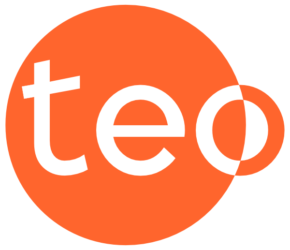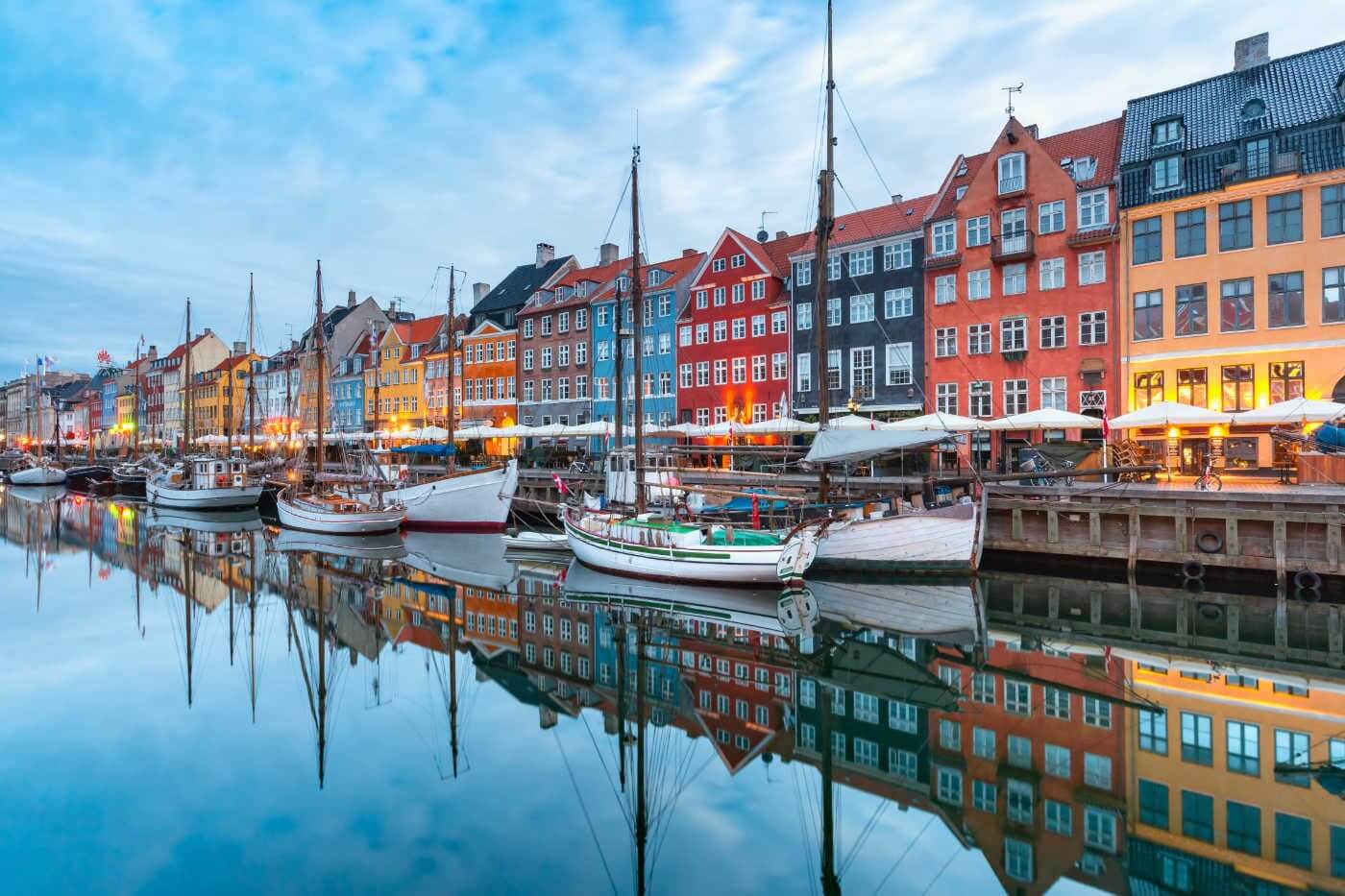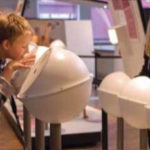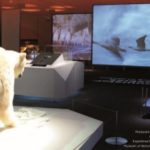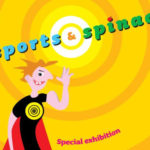Teo: You were the director of the Experimentarium for 26 years. What was the exhibitions culture in this leading European science centre?
Asger Høeg: Experimentarium has always had a very large Development Department. In my time there was about 30 people working exclusively on the development of new exhibitions and educational materials, and continuously researching new ways of communicating science. The exhibitions programme was based on a mix of in-house productions, co-productions with partner institutions, and rented exhibitions. The main exhibitions we rented were Dinosaurs exhibitions from the Natural History Museum in London and Body Worlds. Body Worlds doesn’t has sometimes been subject to negative rumours but it really is an amazing exhibition and was definitely a great success with our audiences. In terms of co-productions, we created Senses and Extremes, two major exhibitions in consortium with Naturalis in Leiden and the Natural History Museum in Brussels. The exhibitions travelled to each venue of our group for about 11 months and then we made it available for other venues to rent. We also co-produced a Winter Sports exhibition with the Vilvite Science Centre in Norway, the Technical Museum in Stockholm and the Heureka Science Centre in Finland. The project toured from 2014 to 2018 to all partnering venues and now it’s going to be presented in Hong Kong. We developed and produced The SPY Exhibition together with Technoplis in Mechelen, Flanders (and sold it later to Techmania in Pilsen, The Czech Republic).
Temporary exhibitions should be considered in their relation to the main exhibition of the science centre.
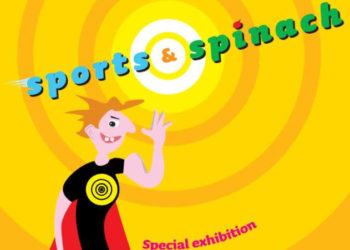
So touring exhibitions represent an essential part of the Experimentarium’s programme. Science centres, internationally, seem to present increasing numbers of travelling shows as part of programmes that tend to become more and more dense, ambitious and far reaching. What do you feel are the primary incentives for a science centre to host a travelling exhibition?
Temporary exhibitions should be considered in their relation to the main exhibition of a science centre. For instance, a core mission of the Experimentarium is to stimulate the interest in science and technology into the community (with a special focus on the younger generation) and therefore to get the largest numbers of visitors as possible. To meet this objective, the core business model is to attract visitors via travelling exhibitions and make sure that after visiting them, they spend a long time in the main exhibition. The travelling exhibtions are the honey that makes visitors come back to the science centre.
Traveling exhibitions contribute to maintain a high number of visitors. If you look at most newly opened museums and science centres, they welcome a lot of visitors in the beginning – because of the news of interest. But after 18 months the honeymoon period is over and the number of visitors falls down. History shows that institutions usually on the long run only reach a level of about 60 percent of the number of visitors they had in the first year. At the Experimentarium we had 530,000 visitors the first year in 1991. In year four we only had 265,000 visitors. We found out that the only way to increase visitor numbers was to present international touring exhibitions. It is not good enough to make new exhibitions in your main exhibition. Visitors feel there is no urge to go there tomorrow because it will still be there next year. With a touring exhibition, you need to go now. Our business model at the Experimentarium was to always introduce a new exhibition just before the winter holidays (in February) and another one before the autumn semester (in October) so as to constantly have a new offer on. From 1991 until 2013, the average annual number of visitors to Experimentarium was 345.000.
So touring exhibitions can thus be considered as marketing magnets that drive visitors through your doors. But how does it work economically? Are there economic incentives for the presentation of international touring exhibitions in science centres?
As I explain in my book Leading Cultural institutions1, economy is at the core of decision making, because at the end of the day you’re not able to run a science centre without money. One of the unique selling points of travelling exhibitions is that, in my experience, they are the cheapest way to present new content to your visitors. If you look at the Winter Sports exhibition we co-produced, the project costed a little bit more than 2 million euros. But we had four pairs of shoulders to carry the burden, so it only costed Experimentarium about 500,000 euros. This way it became much cheaper to co-produce than to create it fully by ourselves, or to develop a new area in the permanent exhibition, which would have costed perhaps three or four times as much as hosting a travelling project.
And when the traveling exhibition has been displayed at the “mother” institutions, it is ready to be rented out which also generate assets.
In the same way, renting a touring exhibition would be in the region of 400,000 euros for projects of that calibre. When developing a full new main exhibition could cost about 2 million euros, it is clearly economically advantageous to consider travelling exhibitions for science institutions.
Touring exhibitions can thus be considered a very interesting asset contributing to the overall sustainability of the organisation?
Yes, and to ensure the continuous appeal of these institutions, I think more and more touring exhibitions will be needed.
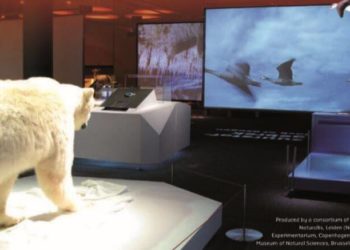
Co-productions are a unique source of synergies and creativity.
Beyond these marketing and financial aspects, what makes it uniquely appealing for science institutions to specifically enter into co-production partnerships, like for the Senses, Extremes and Sports exhibitions you worked on ?
Co-productions are a unique source of synergies and creativity. With people from each partner institution getting committed to the project, you create a brand new team. They have to blend their cultures and learn from each other, which is extremely valuable. I have a good example where sharing different perspectives fostered originality from the Winter Sports exhibition. You know that in Denmark we do not have so much snow, in comparison to Finland, Norway and Sweden. But many of us Danes go skiing into the Alps, and when we have been skiing all day, then we go for what we call “after skiing”. The Danes actually contributed to the concept by adding an after skiing part in the exhibition where you could sit down, have a drink and look at high moments of the winter sports on the television. That was a long established cultural experience we wanted to share.
So when developing touring exhibitions in multi country partnerships, you create new value and nurture new creativity because you confront different cultures. What about the encounter of natural history museum and science centre “cultures”? These must be quite different.
When teams from natural history museums and science centres co-develop a project, they strengthen their offer learning from each other’s areas of expertise. Natural history institutions and technical museums learn about hands-on activities and interactives, and science centres can embrace more the value of objects. In the making of our exhibitions with natural history institutions, we understood that science experiments can really be enhanced when they are linked to an object. For example, to present the science of luminescence, we had a mural interactive where you could “freeze your shadow” with glow paint. Leaving the black room we complemented this experience with some natural specimens illustrating the glowing effect in nature. In the same way, a Bernoulli blower can be illustrated with a miniature airplane by its side.
Another great example of dialog is to bring in living animals. That is something we have successfully tried several times at the Experimentarium. 20 years ago at the end of our first dinosaur exhibition, we presented living chickens and hens. That was very intriguing for visitors, who were invited to check out the feet of the hens and notice similarities with the T-Rex. They discovered thus that they were the descendants of dinosaurs and that no, the dinosaurs did not all die out. In a similar way, to introduce infrared vision in the Senses exhibition, we had real serpents together with infrared goggles visitors could put on to experience infrared vision at the same time.
It is interesting to see how institutions like Naturhistorisk Museum, in Aarhus, Jutland in Denmark are actually going further and attempt to merge the cultures and missions of a science centre and a natural history museum. They develop a genuine hybrid form of institution where visitors would get the best of both worlds.
Looking back at all these travelling projects you have seen grow and live, how did you manage to select the most appealing themes for your audiences?
Exhibitions need to have what we call the “X Factor”. They need to stand on a “strong brand”, a theme that has strong value for visitors, like Dinosaurs, Sports or the Human Body. If you make an exhibition about one of these topics, you already are a 50 percent success. Also, as you see with the Human Body exhibition, a successful recipe is to focus the exhibition on the most interesting thing in the world for you. And it is YOU! Exhibitions that enable the visitor to discover more about themselves are usually very popular.
More widely, you should always consider your visitor as one of your best advisers. At the Experimentarium, we handed out a questionnaire to 12 random chosen visitors every day. With more than 3000 answers every year we could really assess our performance and get a good glimpse of their expectations.
Modern consumers do not buy products anymore. They buy concepts.
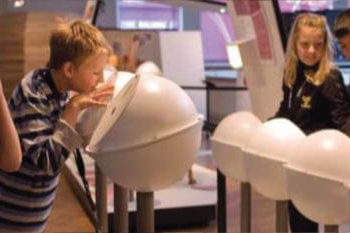
Once you have identified a theme of interest, what are the key criteria you look for in an exhibition that you will present to your audiences?
Quality of experience. In 1998 Pine and Gilmore made a very famous article called “Welcome to the experience economy”, which led to a book one year later. It highlighted the shift from the “service economy” to the “experience economy”. Modern consumers do not buy products anymore. They buy concepts. And visiting a science centre is a concept which starts with the mother Saturday morning saying “what are we going to do this afternoon” and going on the website of your institution. Everything in the experience, from that moment, matters. How information is provided online, on the road and in the centre. Waiting times. Accuracy of maps. The experience in the café, the toilets, the shop. And the interaction with the museum staff. Everything in the global experience will impact the value of your exhibition. As experience providers, we need to consider every pearl on the string of that experience.
From the moment when the visitor pushes the doors of the exhibition, what do you feel will make it a valuable memorable experience for this person?
It is transformation. Pine and Gilmore anticipated that we were shifting towards the “transformation economy”, where consumers value experiences that actually transform them. For example the core purpose of Experimentarium is to stimulate interest in science and technology across all ages, with a special focus on the younger generation. So the offering of Experimentarium is to deliver a transformation: Transforming the visitor so (s)he becomes keen to know more about science and technology. This concept of transformation is the most important offering that you can give to a person, in an era where most people reach the top of Maslow’s Hierarchy of Needs and aspire to accomplish themselves as individuals. Getting to know themselves, in the philosophical manner that was described by Kierkegaard, the Danish philosopher. The visitor is an “aspirant” who aspires to be changed. When you deliver a transformative experience, you make it possible for your visitors to come one step closer to who they are. A good touring exhibition should deliver such an experience.
During two years, Experimentarium presented the marvellous exhibition Dialogue in the Dark where blind people guide you through an hour experience in totally black rooms. That was a transformational experience for many of our visitors!
I guess this would require a full book, but how do you feel transformation could be delivered through science touring exhibitions?
Exhibits need to make it easy for visitors of all ages to relate individually, and we should try to cultivate, through exhibitions, a more individual dialogue with the visitor. Visitors can actually be invited to become part of the exhibition, for instance through mobile devices that profile them with a few questions. Each visitor can thus receive relevant location based content, engage with personalised interactivity and receive some sort of reward with a certificate – people love certificates, and other gamification tools. This personalised engagement should be considered not only throughout the exhibition, but also after their visit.
1 Asger Høeg, Leading cultural institutions : 43 recommendations for successful leadership of cultural institutions, Asger Hoeg Publishing, 2017

About Asger Høeg
Asger Høeg was the CEO of the Experimentarium Science Centre in Copenhagen, Denmark, for 26 years. He is an honorary member of the European Network of Science Centres and Museums (ECSITE) and the Nordisk Science Center Forbund (NSCF). He was an active member in the Board of the Association of Science and Technology Centers (ASTC), and is involved in the boards of many cultural institutions in Denmark and internationally. Asger Høeg is an associate lecturer at the Copenhagen Business School and the author of articles and a book reflecting on good practice for international science centres, notably Leading Cultural institutions published in 2014.
 About Asger Høeg
About Asger Høeg
Asger Høeg was the CEO of the Experimentarium Science Centre in Copenhagen, Denmark, for 26 years. He is an honorary member of the European Network of Science Centres and Museums (ECSITE) and the Nordisk Science Center Forbund (NSCF). He was an active member in the Board of the Association of Science and Technology Centers (ASTC), and is involved in the boards of many cultural institutions in Denmark and internationally. Asger Høeg is an associate lecturer at the Copenhagen Business School and the author of articles and a book reflecting on good practice for international science centres, notably Leading Cultural institutions published in 2014.
Temporary exhibitions should be considered in their relation to a science center’s main exhibition
Teo: You were the director of the Experimentarium for 26 years. What was the exhibitions culture in this leading European science centre?
Asger Høeg: Experimentarium has always had a very large Development Department. In my time there was about 30 people working exclusively on the development of new exhibitions and educational materials, and continuously researching new ways of communicating science. The exhibitions programme was based on a mix of in-house productions, co-productions with partner institutions, and rented exhibitions. The main exhibitions we rented were Dinosaurs exhibitions from the Natural History Museum in London and Body Worlds. Body Worlds doesn’t has sometimes been subject to negative rumours but it really is an amazing exhibition and was definitely a great success with our audiences. In terms of co-productions, we created Senses and Extremes, two major exhibitions in consortium with Naturalis in Leiden and the Natural History Museum in Brussels. The exhibitions travelled to each venue of our group for about 11 months and then we made it available for other venues to rent. We also co-produced a Winter Sports exhibition with the Vilvite Science Centre in Norway, the Technical Museum in Stockholm and the Heureka Science Centre in Finland. The project toured from 2014 to 2018 to all partnering venues and now it’s going to be presented in Hong Kong. We developed and produced The SPY Exhibition together with Technoplis in Mechelen, Flanders (and sold it later to Techmania in Pilsen, The Czech Republic).So touring exhibitions represent an essential part of the Experimentarium’s programme. Science centres, internationally, seem to present increasing numbers of travelling shows as part of programmes that tend to become more and more dense, ambitious and far reaching. What do you feel are the primary incentives for a science centre to host a travelling exhibition?
Temporary exhibitions should be considered in their relation to a science center’s main exhibition. For instance, a core mission of the Experimentarium is to stimulate the interest in science and technology into the community (with a special focus on the younger generation) and therefore to get the largest numbers of visitors as possible. To meet this objective, the core business model is to attract visitors via travelling exhibitions and make sure that after visiting them, they spend a long time in the main exhibition. The travelling exhibtions are the honey that makes visitors come back to the science centre. Traveling exhibitions contribute to maintain a high number of visitors. If you look at most newly opened museums and science centres, they welcome a lot of visitors in the beginning – because of the news of interest. But after 18 months the honeymoon period is over and the number of visitors falls down. History shows that institutions usually on the long run only reach a level of about 60 percent of the number of visitors they had in the first year. At the Experimentarium we had 530,000 visitors the first year in 1991. In year four we only had 265,000 visitors. We found out that the only way to increase visitor numbers was to present international touring exhibitions. It is not good enough to make new exhibitions in your main exhibition. Visitors feel there is no urge to go there tomorrow because it will still be there next year. With a touring exhibition, you need to go now. Our business model at the Experimentarium was to always introduce a new exhibition just before the winter holidays (in February) and another one before the autumn semester (in October) so as to constantly have a new offer on. From 1991 until 2013, the average annual number of visitors to Experimentarium was 345.000.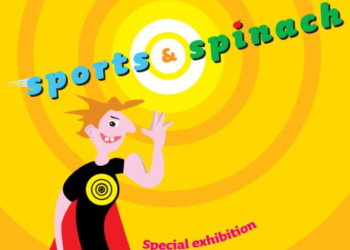
So touring exhibitions can thus be considered as marketing magnets that drive visitors through your doors. But how does it work economically? Are there economic incentives for the presentation of international touring exhibitions in science centres?
As I explain in my book *Leading Cultural institutions1, economy is at the core of decision making, because at the end of the day you’re not able to run a science centre without money. One of the unique selling points of travelling exhibitions is that, in my experience, they are the cheapest way to present new content to your visitors. If you look at the Winter Sports exhibition we co-produced, the project costed a little bit more than 2 million euros. But we had four pairs of shoulders to carry the burden, so it only costed Experimentarium about 500,000 euros. This way it became much cheaper to co-produce than to create it fully by ourselves, or to develop a new area in the permanent exhibition, which would have costed perhaps three or four times as much as hosting a travelling project. And when the traveling exhibition has been displayed at the “mother” institutions, it is ready to be rented out which also generate assets. In the same way, renting a touring exhibition would be in the region of 400,000 euros for projects of that calibre. When developing a full new main exhibition could cost about 2 million euros, it is clearly economically advantageous to consider travelling exhibitions for science institutions.Touring exhibitions can thus be considered a very interesting asset contributing to the overall sustainability of the organisation?
Yes, and to ensure the continuous appeal of these institutions, I think more and more touring exhibitions will be needed.Co-productions are a unique source of synergies and creativity
Beyond these marketing and financial aspects, what makes it uniquely appealing for science institutions to specifically enter into co-production partnerships, like for the Senses, Extremes and Sports exhibitions you worked on ?
Co-productions are a unique source of synergies and creativity. With people from each partner institution getting committed to the project, you create a brand new team. They have to blend their cultures and learn from each other, which is extremely valuable. I have a good example where sharing different perspectives fostered originality from the Winter Sports exhibition. You know that in Denmark we do not have so much snow, in comparison to Finland, Norway and Sweden. But many of us Danes go skiing into the Alps, and when we have been skiing all day, then we go for what we call ‘after skiing’. The Danes actually contributed to the concept by adding an after skiing part in the exhibition where you could sit down, have a drink and look at high moments of the winter sports on the television. That was a long established cultural experience we wanted to share.So when developing touring exhibitions in multi country partnerships, you create new value and nurture new creativity because you confront different cultures. What about the encounter of natural history museum and science centre ‘cultures’? These must be quite different.
When teams from natural history museums and science centres co-develop a project, they strengthen their offer learning from each other’s areas of expertise. Natural history institutions and technical museums learn about hands-on activities and interactives, and science centres can embrace more the value of objects. In the making of our exhibitions with natural history institutions, we understood that science experiments can really be enhanced when they are linked to an object. For example, to present the science of luminescence, we had a mural interactive where you could “freeze your shadow” with glow paint. Leaving the black room we complemented this experience with some natural specimens illustrating the glowing effect in nature. In the same way, a Bernoulli blower can be illustrated with a miniature airplane by its side.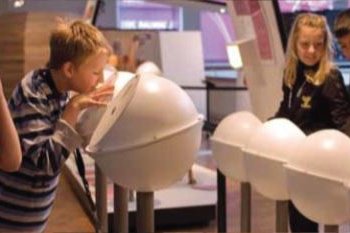 Another great example of dialog is to bring in living animals. That is something we have successfully tried several times at the Experimentarium. 20 years ago at the end of our first dinosaur exhibition, we presented living chickens and hens. That was very intriguing for visitors, who were invited to check out the feet of the hens and notice similarities with the T-Rex. They discovered thus that they were the descendants of dinosaurs and that no, the dinosaurs did not all die out. In a similar way, to introduce infrared vision in the Senses exhibition, we had real serpents together with infrared goggles visitors could put on to experience infrared vision at the same time.
It is interesting to see how institutions like Naturhistorisk Museum, in Aarhus, Jutland in Denmark are actually going further and attempt to merge the cultures and missions of a science centre and a natural history museum. They develop a genuine hybrid form of institution where visitors would get the best of both worlds.
Another great example of dialog is to bring in living animals. That is something we have successfully tried several times at the Experimentarium. 20 years ago at the end of our first dinosaur exhibition, we presented living chickens and hens. That was very intriguing for visitors, who were invited to check out the feet of the hens and notice similarities with the T-Rex. They discovered thus that they were the descendants of dinosaurs and that no, the dinosaurs did not all die out. In a similar way, to introduce infrared vision in the Senses exhibition, we had real serpents together with infrared goggles visitors could put on to experience infrared vision at the same time.
It is interesting to see how institutions like Naturhistorisk Museum, in Aarhus, Jutland in Denmark are actually going further and attempt to merge the cultures and missions of a science centre and a natural history museum. They develop a genuine hybrid form of institution where visitors would get the best of both worlds.
Looking back at all these travelling projects you have seen grow and live, how did you manage to select the most appealing themes for your audiences?
Exhibitions need to have what we call the “X Factor”. They need to stand on a “strong brand”, a theme that has strong value for visitors, like Dinosaurs, Sports or the Human Body. If you make an exhibition about one of these topics, you already are a 50 percent success. Also, as you see with the Human Body exhibition, a successful recipe is to focus the exhibition on the most interesting thing in the world for you. And it is YOU! Exhibitions that enable the visitor to discover more about themselves are usually very popular. More widely, you should always consider your visitor as one of your best advisers. At the Experimentarium, we handed out a questionnaire to 12 random chosen visitors every day. With more than 3000 answers every year we could really assess our performance and get a good glimpse of their expectations.Modern consumers do not buy products anymore. They buy concepts.
Once you have identified a theme of interest, what are the key criteria you look for in an exhibition that you will present to your audiences?
Quality of experience. In 1998 Pine and Gilmore made a very famous article called “Welcome to the experience economy”, which led to a book one year later. It highlighted the shift from the “service economy” to the “experience economy”. Modern consumers do not buy products anymore. They buy concepts. And visiting a science centre is a concept which starts with the mother Saturday morning saying ‘what are we going to do this afternoon’ and going on the website of your institution. Everything in the experience, from that moment, matters. How information is provided online, on the road and in the centre. Waiting times. Accuracy of maps. The experience in the café, the toilets, the shop. And the interaction with the museum staff. Everything in the global experience will impact the value of your exhibition. As experience providers, we need to consider every pearl on the string of that experience.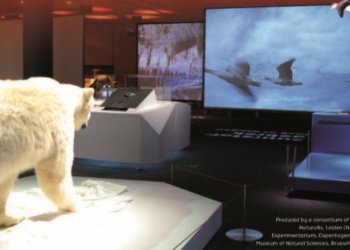
From the moment when the visitor pushes the doors of the exhibition, what do you feel will make it a valuable memorable experience for this person?
It is transformation. Pine and Gilmore anticipated that we were shifting towards the “transformation economy”, where consumers value experiences that actually transform them. For example the core purpose of Experimentarium is to stimulate interest in science and technology across all ages, with a special focus on the younger generation. So the offering of Experimentarium is to deliver a transformation: Transforming the visitor so (s)he becomes keen to know more about science and technology. This concept of transformation is the most important offering that you can give to a person, in an era where most people reach the top of Maslow’s Hierarchy of Needs and aspire to accomplish themselves as individuals. Getting to know themselves, in the philosophical manner that was described by Kierkegaard, the Danish philosopher. The visitor is an “aspirant” who aspires to be changed. When you deliver a transformative experience, you make it possible for your visitors to come one step closer to who they are. A good touring exhibition should deliver such an experience. During two years, Experimentarium presented the marvellous exhibition “Dialogue in the Dark” where blind people guide you through an hour experience in totally black rooms. That was a transformational experience for many of our visitors!I guess this would require a full book, but how do you feel transformation could be delivered through science touring exhibitions?
Exhibits need to make it easy for visitors of all ages to relate individually, and we should try to cultivate, through exhibitions, a more individual dialogue with the visitor. Visitors can actually be invited to become part of the exhibition, for instance through mobile devices that profile them with a few questions. Each visitor can thus receive relevant location based content, engage with personalised interactivity and receive some sort of reward with a certificate – people love certificates, and other gamification tools. This personalised engagement should be considered not only throughout the exhibition, but also after their visit.1 Asger Høeg, Leading cultural institutions : 43 recommendations for successful leadership of cultural institutions, Asger Hoeg Publishing, 2017
